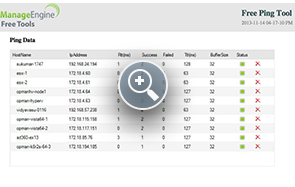

Example.Īs described in a previous blog post, when we run latency tests at Google in a cloud environment, our tool of choice is PerfKit Benchmarker (PKB). *Note: this uses global options: -H for remote-host and -t for test-name with a test-specific option -o for output-selectors. Here’s an example of using the test-specific -o flag so netperf outputs several latency statistics: With the -o flag, you can customize the output metrics to display the exact information you're interested in. In netperf, the TCP_RR and UDP_RR (RR=request-response) tests report round-trip latency.
GLOBAL PING TOOL PLUS
Network testing tools such as netperf can perform latency tests plus throughput tests and more. Ping does this using ICMP packets, and several tools based on ping such as nping, hping, and TCPing perform the same measurement using TCP packets.įor example, using the following command, ping sends one ICMP packet per second to the specified IP address until it has sent 100 packets. Which tools and whyĪll the tools in this area do roughly the same thing: measure the round trip time (RTT) of transactions. We'll also share our recommended commands for consistent, repeatable results running both intra-zone cluster latency and inter-region latency benchmarks. Google has lots of practical experience in latency benchmarking, and in this blog, we’ll share techniques jointly developed by Google and researchers at Southern Methodist University’s AT&T Center for Virtualization to inform your own latency benchmarking before and after migrating workloads to the cloud. And in most cases, we believe netperf returns the more representative answer to the question-you just need to pay attention to the details.

A common question for cloud architects is “Just how quickly can we exchange a request and a response between two endpoints?” There are several tools for measuring round-trip network latency, namely ping, iperf, and netperf, but because they’re not all implemented and configured the same, different tools can return different results.


 0 kommentar(er)
0 kommentar(er)
